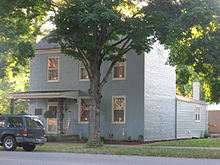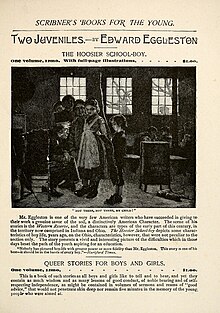| Edward Eggleston | |
|---|---|
 | |
| Born | (1837-12-10)December 10, 1837 Vevay, Indiana, U.S. |
| Died | September 3, 1902(1902-09-03) (aged 64) Lake George, New York, U.S. |
| Occupation |
|
| Notable works | The Hoosier Schoolmaster (1871) |
| Spouses |
|
| Children | Elizabeth Eggleston Seelye, Allegra Eggleston, Blanche Eggleston, Edward William Eggleston |
Edward Eggleston (December 10, 1837 – September 3, 1902) was an American historian and novelist.
Biography
Eggleston was born in Vevay, Indiana on December 10, 1837, to Joseph Cary Eggleston and Mary Jane Craig. The author George Cary Eggleston was his brother. As a child, he was too ill to regularly attend school, so his education was primarily provided by his father. He was ordained as a Methodist minister in 1856. He wrote a number of tales, some of which, especially the "Hoosier" series, attracted much attention. Among these are The Hoosier Schoolmaster, The Hoosier Schoolboy, The End of the World, The Faith Doctor, and Queer Stories for Boys and Girls.
Eggleston used well-known historical events as the basis for several of his novels. In The End of the World, he describes the build-up to the Second Coming of Christ in 1843, as prophesied by William Miller, set in southern Indiana. The Graysons is a fictionalized account of a famous murder trial that Abraham Lincoln won in 1858 in central Illinois. Other books were romanticized stories based on his personal experiences, including The Mystery of Metropolisville, about land speculation in southern Minnesota, and The Circuit Rider, about itinerant preachers, set in southwestern Ohio. Most of his novels contain characters who speak in local "dialect".
He wrote many articles for the children's magazine The Little Corporal, and in 1866, he worked as an editor for the periodical. In December 1866 he accepted a higher-paying editorial position at The Sunday School Teacher. From 1869 to 1877 Eggleston edited the eight-page weekly publication Little Folks, advertised as being "an illustrated Paper, for every Sunday, for Infant Scholars." He wrote two stories for each issue. In 1871 he was briefly the supervising editor of the New York periodical The Independent.
In 1884, Eggleston helped organize the American Historical Association. He was elected its president in 1899. In his presidential address, he called for a change from a history of important battles to one of important lives. Eggleston was elected a member of the American Antiquarian Society in 1893.

His boyhood home at Vevay, Indiana, known as the Edward and George Cary Eggleston House, was listed on the National Register of Historic Places in 1973. His summer home, Owl's Nest, in Lake George, New York, eventually became his year-round home. Eggleston died there on September 3, 1902, at the age of 64. Owl's Nest was declared a National Historic Landmark in 1971.
His oldest daughter, the writer Elizabeth Eggleston Seelye, was married to Elwyn Seelye, the founder of the New York State Historical Association. His second daughter, Allegra Eggleston, was an artist and illustrator. She collaborated with her sister and her father on a number of books including The Story of Columbus, The Story of Washington, and The Graysons. He had a third daughter, Blanche, and a son, Edward William, who died at age 3.
Principal works
Novels
- The Hoosier Schoolmaster (1871)
- The End of the World (1872)
- The Mystery of Metropolisville (1873)
- The Circuit Rider (1874)
- Roxy (1878)
- The Graysons (1888)
- The Faith Doctor (1891)
- Duffels (short stories) (1893)
Juvenile

- Mr. Blake's Walking Stick (1870)
- Tecumseh and the Shawnee Prophet (1878)
- Pocahontus and Powhatan (1879)
- Montezuma (1880)
- The Hoosier Schoolboy (1883)
- Queer Stories for Boys and Girls (1884)
- Stories of Great Americans for Little Americans (1895)
- Home History of the United States (1889)
History
- A History of the United States and Its People (1888)
- The Beginners of a Nation (1896)
- The Transit of Civilization From England to America (1901)
- New Centennial History of the United States (1904)
Religion
- Christ in Art (1875)
- Christ in Literature (1875)
References
- ^ Randel, William Peirce (1946). Edward Eggleston. New York: King's Crown Press.
- Bridges, Karl (2007). 100 great American novels you've (probably) never read. Popular authors series. Greenwood Publishing Group. ISBN 978-1-59158-165-9. Retrieved September 30, 2009.
- "Edward Eggleston". encyclopedia.com. Retrieved September 18, 2024.
- ^ Chisholm 1911.
- Kelly, R. Gordon, Children's Periodicals of the United States, pages 277 - 282, Greenwood Press, 1984
- Pflieer, Pat American Children's Periodicals, 1789-1872 (Kindle Edition), location 9748-9765, Merrycoz Books, 2016
- American Antiquarian Society Members Directory
- "National Register Information System". National Register of Historic Places. National Park Service. July 9, 2010.
- "Edward Eggleston (obituary)" (PDF). The New York Times. September 6, 1902. Retrieved June 15, 2010.
Further reading
- Chisholm, Hugh, ed. (1911). "Eggleston, Edward" . Encyclopædia Britannica. Vol. 9 (11th ed.). Cambridge University Press.
- "Eggleston, Edward." American Authors 1600–1900 The H. W. Wilson Company, New York, 1938
 Cousin, John William (1910), "Eggleston, Edward", A Short Biographical Dictionary of English Literature, London: J. M. Dent & Sons – via Wikisource
Cousin, John William (1910), "Eggleston, Edward", A Short Biographical Dictionary of English Literature, London: J. M. Dent & Sons – via Wikisource
External links
- Works by Edward Eggleston at Project Gutenberg
- Works by or about Edward Eggleston at the Internet Archive
- Works by Edward Eggleston at LibriVox (public domain audiobooks)

- The Transit of Civilization from England to America in the Seventeenth Century
- 1837 births
- 1902 deaths
- 19th-century American historians
- 19th-century American novelists
- Presidents of the American Historical Association
- Novelists from Indiana
- People from Vevay, Indiana
- People from Lake George, New York
- American male novelists
- 19th-century American male writers
- American male non-fiction writers
- Historians from New York (state)
- Members of the American Academy of Arts and Letters